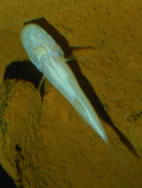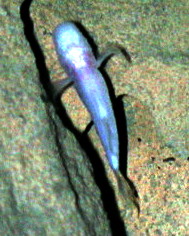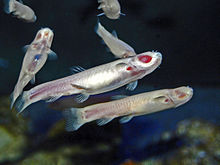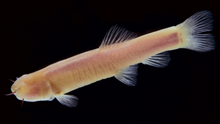
The Mexican tetra, also known as the blind cave fish, blind cave characin, and blind cave tetra, is a freshwater fish of the family Characidae of the order Characiformes. The type species of its genus, it is native to the Nearctic realm, originating in the lower Rio Grande and the Neueces and Pecos Rivers in Texas, as well as the central and eastern parts of Mexico.

The Amblyopsidae are a fish family commonly referred to as cavefish, blindfish, or swampfish. They are small freshwater fish found in the dark environments of caves, springs and swamps in the eastern half of the United States. Like other troglobites, most amblyopsids exhibit adaptations to these dark environments, including the lack of functional eyes and the absence of pigmentation. More than 200 species of cavefishes are known, but only six of these are in the family Amblyopsidae. One of these, Forbesichthys agassizii, spends time both underground and aboveground. A seventh species in this family, Chologaster cornuta, is not a cave-dweller but lives in aboveground swamps.
The golden cave catfish is a critically endangered species of airbreathing catfish. This cavefish is only known to live in the Aigamas cave, Otjozondjupa region, Namibia. It has also been reported from the nearby Dragon's Breath Cave. The golden cave catfish lack pigmentation and are up to 16.1 cm in standard length. They have very small eyes that are covered with skin, and are probably effectively blind. They feed on detritus and invertebrates that fall into the lake in which they live. The population is estimated at 200–400 individuals. Little is known about its reproduction, and attempts to breed it in captivity have failed. The population is threatened by chance events and water extraction from the cave lake, which has resulted in a drop of the water level.

The Alabama cavefish is a critically endangered species of amblyopsid cavefish found only in underground pools in Key Cave, located in northwestern Alabama, United States in the Key Cave National Wildlife Refuge. It was discovered underneath a colony of gray bats in 1967 by researchers Robert A. Kuehne and John E. Cooper and scientifically described in 1974.

Astyanax jordani is a freshwater fish of the characin family of order Characiformes, native to Mexico. It is sometimes called the cave tetra, or by its local Spanish name tetra ciego.
The Somalian blind barb is a ray-finned fish species in the family Cyprinidae. It is the only member of the genus Barbopsis. This troglobitic fish is found only in Somalia.
Caecobarbus geertsi, the African blind barb or Congo blind barb, is a species of cyprinid fish. This threatened cavefish is only known from Democratic Republic of the Congo, and it is the only member of the monotypic genus Caecobarbus. George Albert Boulenger described this fish in 1921 and it apparently lacks any close relatives in the Congo region.
Caecocypris basimi, the Haditha cavefish, is a species of cyprinid fish endemic to Iraq, only occurring in aquifers near Haditha. It is found in an underground sinkhole directly under a shrine the only way to access which is a well 5m below the shrine. This cavefish is the only member of its genus. The species is classed as Critically endangered, possibly extinct, by the IUCN, as there have been no records since 1983 despite a comprehensive survey in 2012. The primary threat is water extraction, which has lowered the groundwater level. It is placed as one of the top 10 lost freshwater fishes to be found.
Garra typhlops, also known as the Iran cave barb is a species of ray-finned fish in the family Cyprinidae. It is endemic to caves in Iran. Like other cave-adapted fish, it is blind and lacks pigmentation.
Eidinemacheilus smithi, also known as the Zagroz blind loach, is a species of loach in the family Nemacheilidae. This cavefish is endemic to an aquifer in the Karun River drainage in the Zagros Mountains of Iran.
Typhlogarra widdowsoni or Garra widdowsoni, the Iraq blind barb or Haditha cave garra, is a species of cyprinid fish endemic to underground water systems near Haditha in Iraq. Although traditionally placed in its own genus Typhlogarra, this is not supported by genetic evidence, leading to its move to Garra. This cavefish is considered critically endangered because of water extraction, which has lowered the groundwater level. Once abundant, a survey in 2012 found that it now was very rare. Another species from the same place, Caecocypris basimi, may already be extinct. The only other known cavefish in Iraq is Eidinemacheilus proudlovei.
Milyeringa is a genus of blind cavefish from the Cape Range and Barrow Island, northwestern Australia. Although traditionally considered to belong to the family Eleotridae, studies show that they represent a distinct and far-separated lineage together with the Typhleotris cavefish from Madagascar, leading some to move them to their own family, Milyeringidae. The generic name is taken from Milyering which is 20 miles (32 km) southwest of Vlamingh Head in the North West Cape of Western Australia, the type locality for Milyeringa veritas.

The Mexican blind brotula is a species of viviparous brotula endemic to Mexico, where it is found in sinkholes and caves. It is known as sak kay in Mayan and dama blanca ciega in Spanish. This cavefish grows to a standard length of 9.7 cm (3.8 in). It is the only known member of its genus.
Stygichthys typhlops, the blind tetra or Brazilian blind characid, is a species of fish in the family Characidae and the only member of the genus Stygichthys. It is endemic to caves in northern Minas Gerais, Brazil. Like other cave-adapted fish, the Brazilian blind characid is blind and lacks pigmentation. It reaches up to about 4.6 cm (1.8 in) in standard length. It is solitary and when kept together in an aquarium, individuals are indifferent to each other.

Typhlichthys subterraneus, the southern cavefish, is a species of cavefish in the family Amblyopsidae endemic to karst regions of the eastern United States.
Uegitglanis zammaranoi is the only species of catfish in the genus Uegitglanis of the family Clariidae. It is endemic to Somalia, where it only occurs in caves near the Jubba and the Shebelle Rivers. This species grows to about 10.1 cm (4.0 in) in total length.

Cavefish or cave fish is a generic term for fresh and brackish water fish adapted to life in caves and other underground habitats. Related terms are subterranean fish, troglomorphic fish, troglobitic fish, stygobitic fish, phreatic fish and hypogean fish.
Lamprologus lethops is a species of cichlid fish from areas with fast current in the Congo River in Central Africa, where it is believed to live in depths as great as 160 m (520 ft) or 200 m (660 ft) below the surface. It reaches up to about 12.5 cm (5 in) in standard length, with females being somewhat smaller than males, is all whitish in color (non-pigmented), and essentially blind as adult, as their eyes are covered in a thick layer of skin. This is entirely unique among cichlids and an adaption to the perpetual darkness of its habitat, similar to the adaptions seen in cavefish. The eyes of juveniles are rudimentary and not covered by skin.
Typhleotris mararybe is a critically endangered species of fish in the family Milyeringidae, the blind cave gobies. It is a troglobitic species endemic to cave habitat in southwestern Madagascar. It is unique among known cave-dwelling fish in that is both blind and darkly pigmented. It has well-developed nonvisual sensory systems and dives to avoid approaching objects. The fish was first collected in 2008 and was described to science as a new species in 2012.
Caecogobius cryptophthalmus is a species of goby that is endemic to underground habitats in Calbiga on the Philippine island of Samar. This species is one of two members of the genus Caecogobius. Like other cavefish, C. cryptophthalmus has reduced eyes and pigmentation.









